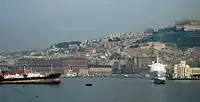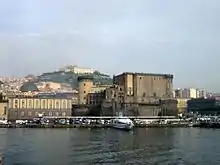Port of Naples
The Port of Naples is one of the largest Italian seaports and one of the largest seaports in the Mediterranean Sea basin having an annual traffic capacity of around 25 million tons of cargo and 500,000 TEU's.
| Port of Naples | |
|---|---|
 Harbour | |
| Location | |
| Country | Italy |
| Location | Naples |
| Details | |
| Owned by | Port Authority of Naples |
| Type of harbor | Natural/Artificial |
| Size of harbor | 266 ha (2.66 sq km) |
| Land area | 142.6 ha (1.426 sq km) |
| Size | 408.6 ha (4.086 sq km) |
| Available berths | 38 |
| Wharfs | 75 |
| Employees | 4,866[1] (2007) |
| General manager | Antonio Del Mese |
| Statistics | |
| Vessel arrivals | 63,788 vessels (2008)[2] |
| Annual cargo tonnage | 20,269,163 tonnes (2007)[1] |
| Annual container volume | 460,812 TEU's (2007)[2] |
| Passenger traffic | 8,988,056 people (2007) |
| Annual revenue | US$ 950 million (2007)[1] |
| Net income | US$ 253 million (2007)[1] |
| Website www.porto.napoli.it | |
The port is also an important employer in the area having more than 4,800 employees that provide services to more than 64,000 ships every year.
General information
_-_n._709._Strada_del_molo_a_Napoli.jpg.webp)
_-_View_of_Forte_Sant'Elmo.jpg.webp)


The Port of Naples is situated in the centre of Naples, very close to the central Piazza Municipio, near Piazza Garibaldi (FS and MN terminals) and about 15 km (9.3 mi) from Naples Airport.
Activity

In 2007 the Port of Naples handled 20,269,163 tonnes of cargo and 460,812 TEU's making it one of the busiest cargo ports in Italy and one of the largest container ports in the country.[2]
| Type | Quantity |
|---|---|
| RoRo | 7,135,851* |
| Liquid bulk | 4,454,580* |
| Dry bulk | 4,705,940* |
| Nr of passengers | 8,988,056 |
| Containers (TEU's) | 560,812 |
| Containers | 3,972,792* |
| Total | 20,269,163* |
*tonnes
Terminals
Container terminal
The terminal has a storage capacity of 1,336,000 m2, 70 mooring places, 11.5 km of docks[3] and an annual traffic capacity of around 500,000 TEU's.
Commercial cargo
The commercial cargo section of the port has four terminals: one for timber, one for cellulose and two for cereals with a total storage area of 75,000 m2 (810,000 sq ft) (35,000 sq m for timber and cellulose and 40,000 sq m for cereals).[3]
Automobile terminal
The Port of Naples has one RoRo terminal with a total length of 850 m, a land area of 120,000 m2, storage capacity of 8,000 cars and a transshipment capacity of 900,000 units per year. The daily traffic with Sicily alone is 700 vehicles per day.[4]
In 2007 the RoRo terminal handled 370,000 trucks and 475,000 cars.[5]
Passenger terminal
_Naples%252C_Campania%252C_Italy%252C_South_Europe.jpg.webp)
The Port of Naples is one of the largest passenger ports in Italy and one of the largest passenger ports in Europe with a total traffic of 8,988,056 people in 2007.[2]
The cruise terminal has ten mooring places, seven mobile walkways, 12 computerised check-in desks[6] and an annual traffic capacity of around 1.5 million passengers.
Shipyard
The shipyards are an important part of the Port of Naples. The structures of the ports shipyards consist of 3 brick-built docks and 4 floating docks.
The sector involves four large companies and 60 small workshops which undertake ship repairs, that have a total number of 2,000 employees[7] and a turnover over US$200 million.
References
- "Annual Report 2007" Archived 2011-07-22 at the Wayback Machine. Port Authority of Naples. Retrieved 2 July 2013.
- "Modello ESPO 2007" (PDF). Port Authority of Naples. Archived from the original (PDF) on 22 July 2011.
- "Containers" Archived 2011-03-01 at the Wayback Machine. Port Authority of Naples. Retrieved 2 July 2013.
- "Ro-ro" Archived 2014-06-15 at the Wayback Machine. Port Authority of Naples. Retrieved 2 July 2013.
- "Table of traffic". Port Authority of Naples. Archived from the original on 16 September 2008.
- "Cruise terminal" Archived 2008-09-16 at the Wayback Machine. Port Authority of Naples. Retrieved 2 July 2013.
- "Shipyards and repairs yards" Archived 2007-08-14 at the Wayback Machine. Port Authority of Naples. Retrieved 2 July 2013.
External links
- "History of the port". Port Authority of Naples.
| Wikimedia Commons has media related to Harbour of Naples. |
